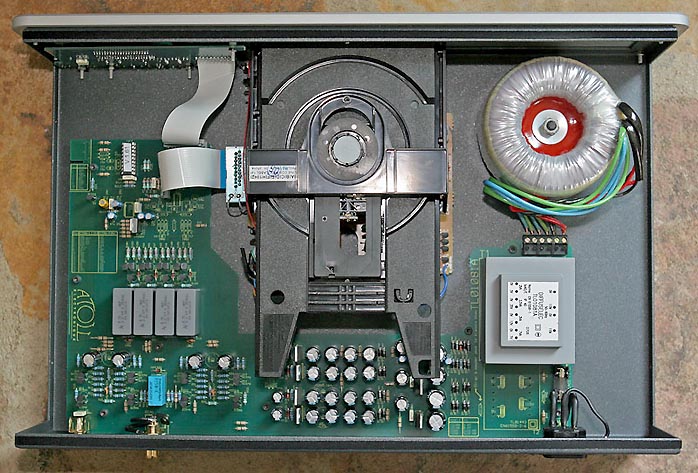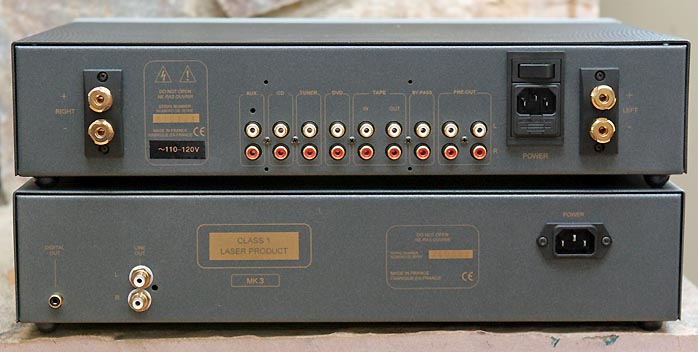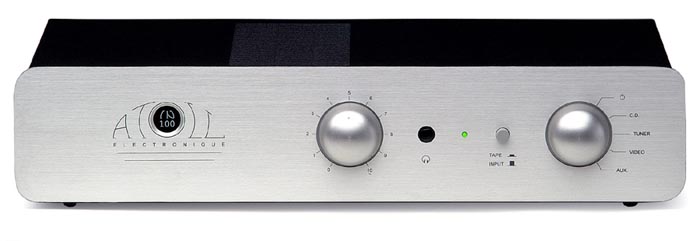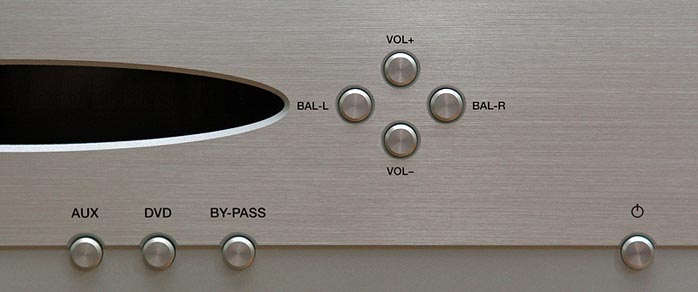Atoll CD/IN200 6moons.com Review
Reviewer: Frederic Beudot
Digital Source: Musical Fidelity A5 CD, Accuphase DP55
Integrated Amplifier: Musical Fidelity A5, McIntosh MA2275, Onix SP3, Sphinx Project10
Headphones and amps: Musical Fidelity Xcanv3, beyerdynamic DT911, AKG K701
Cables: Zu Gede, Zu Libtec, Consonance Billies, Slinkylinks RCA [in for review]
Power Cords: Cobalt Ultimate
Powerline conditioning: Monster Power HTS5100 MkII
Sundry accessories: Isolpads under electronics and speakers, Standesign stand
Room size: 15′ x 30′ opening to three other rooms. Short wall setup
Review component retail: $2,000 for Atoll CD200 | $2,250 for Atoll IN200

Few people even in France know of Brecey. If anything, they will remember passing a sign on their way to Mont Saint-Michel. The most adventurous will brag of a night spent in a charming B&B in the heart of the “bocage of Basse-Normandie”. But nobody, even the most imaginative, would mistake Brecey for Silicon Valley. Yet one of the most successful French HiFi companies of recent years has decided to settle there exactly ten years ago. They have been harvesting awards and ‘best component of the year’ titles ever since – even Stereophile gave in to their charms and granted them three ‘recommended component’

distinctions for their pre/power/CD separates in late 2006, following multiple awards since 2002.

When Stephane and Emmanuel Dubreuil created Atoll in 1997, quality Chinese gear was not a given as it is today. Both settled on a mission to create affordable, high-quality audiophile equipment that would be assembled in France using components purchased from French contractors, as opposed to offshore OEM that would be rebranded and sold at a mighty profit. Challenging as this goal may have been back in 1997, there is no doubt that Atoll was successful. Myriad of accolades received worldwide attest to it. The real question today is whether this approach remains sustainable against the ever-increasing Chinese quality production. Numerous reviews of Raysonic, Opera or Shanling gear just to name a few suggest highly competitive examples. More importantly even, can this recipe hold against the unending trend of European and US companies which relocate production to areas with lower manufacturing costs? After all, even Musical Fidelity’s A and X series are now made in Taiwan to reduce these costs.
France is one of the countries with the highest labor cost in the world but — and this is not part of the typical stereotypes — it is also a land of very skilled, hard-working and energetic technicians and entrepreneurs. So when the solicitation came around to review Atoll’s latest offerings, I just could not pass up an opportunity to see how the little start-up had grown up and how much music it could pack into $2,000 per box at this time of intense international competition and highly unfavorable Euro-to-Dollar exchange rates. I’ll tell you upfront, they did not disappoint. If I sometimes despair at the immobility of my fellow citizens, examples like Atoll’s give me reasons to keep hoping.

Back in 1997, Atoll had two relatively low-powered solid-state integrateds (IN50 and IN80) with their stereo power amplifier counterparts (AM50, AM80) as well as a preamp (PR100). Three CD players joined the product line a year later (CD50, CD80, CD100). The reason why I am mentioning those first models is that they’re still in the catalog today even if they have been through multiple generations (3 for the CD players) and incremental improvements. It is fairly revealing of Atoll’s philosophy that the eight components they started with remain at the heart of their catalog ten years later. They do pack as much sound quality as they can into their designs upfront, evolving and refining them as technology allows them to do cost-effectively to establish them in the market for the long run. Affordability does not necessarily have to mean disposable and unreliable. Atoll would not have survived in the market for ten years had this been their business model.
Atoll’s line has considerably expanded since then, counting 21 different models sold in the US among which are four CD players (from $1000 to $2,000), four integrated amps (from $1,000 to $2,250), three preamps ($1,000 to $2,000), four power amps ($1,000 to $2,000, each bridgeable to monoblock) and even a tuner ($1,000). For the number-oriented among us, this obviously does not add up to 21 and Atoll also offers an audio/video line with a 5.1 preamp ($2,500 without the optional DSP module) and four power amps ($1,000 to $1,500 for the 3 channel amps, $2,000 for the 5x100wpc AV500). From $2,000 (CD50 + IN50) up to over $12,500 (with 5 bridged AM200 and a PR5.1 if you ever need that much power on tap), Atoll can offer systems susceptible to satisfy most budgets. What I set out to find was whether they could also satisfy one’s musical thirst.

The gear I received for review was Atoll’s top-of-the-line CD player (CD200, $2,000) and integrated amplifier (IN 200, $2,250) which can be bought separately or together for a limited time for $3,500. The CD player was already broken in so it took duty in my various systems immediately and was actually my reference player for the series of reviews on balanced headphone amplifiers I published over the past few weeks. The integrated amplifier on the other hand was fresh out of production and required significant break-in. Count at least 300 hours before it comes to full life and don’t even think about forging an opinion before this mark (and don’t ask me how I know either).
Even though it uses the same chassis to reflect a unified brand aesthetic, the CD200 differs from its less ambitious siblings in various fashions. All players use the same Philips VAM 1202 mechanism built on a special anti-vibration chassis but the CD200 boasts a newer 24 bit/192kHz 8x oversampling Burr-Brown DAC claiming added dynamics. But it is the power supply stages that received the most attention with separate toroidal transformers for analog and digital sections and 17000µF of storage capacity. Both current/voltage conversion and output sections operate in pure Class A with fully discrete components for an S/N ratio of over 105dB and improved slew rates versus the other players – as well as a much reduced output impedance.
Construction quality seemed fairly good, right on par with my Musical Fidelity A5. There’s a heavy aluminum front plate and a case of lighter built. The design won’t get any prize for originality with its fairly plain grey look (I have not seen the black version available at no additional charge), its smallish display and engraved Atoll logo on the left yet my wife preferred it to the A5 which she finds too “macho” with its rough edges and large black handles. Hence the Atolls get the prize as far as WAF at the Beudot household is concerned.

The CD tray, like with all mid-priced CD players built on a Philips platform, is fairly noisy and brutal but actually slightly better damped than the A5’s yet neither would get a compliment for smoothness of operation. A few items betrayed the economy approach of Atoll – the CD200 does not have a balanced output and the display cannot be dimmed or turned off. Such bells and whistles come standard on the cheaper Chinese/Canadian Raysonic 128 for example. If I were to express two regrets, it would be the lack of an optical digital output (but the player has a RCA digital output) and the absence of a digital input to use the internal DAC with other digital sources. Clearly, to keep the whole package below $2,000, some things had to give. It simply seems that a few more gave on the CD200 than on most competitive packages.
One interesting thing about the Atoll was that it uses the same Philips IR protocols as the A5 CD and so could be piloted by the same remote that controls the Musical Fidelity A5 integrated amplifier. So obviously the first thing I did was to plug both players into the A5, make two copies of my usual test CD (a personal medley covering all sorts of styles and records that I know in and out), feed one to each player and hit play.
Going through the various tracks on the disc and toggling between the two inputs with the remote, you probably could have seen me lose my composure progressively and start scratching my balding head now devoid of most hair. I just could not tell the players apart. Nothing, absolutely no difference. Zip, que dalle. I was actually very happy for the Atoll but felt quite bad that the A5 had nothing to show for its additional $500 and tubed output. In hindsight, the A5 amp has such a strong personality that it probably masked whatever nuances existed between both players. To help me verify this hypothesis, I then plugged the players into the now departed Rudistor NX-33 headphone amplifier and slight differences began to appear. The Atoll had a slightly more open and airy upper midrange, the A5 was a touch darker with just a bit more texture. It was only after multiple listening sessions through the McIntosh MA2275 integrated that I managed to clearly identify the differences between the two players.
The Atoll is very detailed and digs deep into the music. Its resolving power proved a real match to the sweet musicality of the Rudistor and McIntosh amps. It also has a fairly open upper midrange but without any aggression which we’ll see allowed the Atoll combo to reveal the music hidden inside even fairly compressed recordings. What you need to know though is that to unlock this player’s ability to extract small details and light the music from within, you will have to sit it on vibration absorption devices. I tried the SoundQuest Isolpads and the match was perfect. At $25 for four, I doubt that many solutions exist that would be more cost effective but feel free to experiment. The improvements provided on the Atoll gear (both CD player and amplifier) were far from negligible. I would go as far as saying that such devices are mandatory if you want to really understand what the Atoll gear is capable of.
On the other hand, the CD200 did not have quite the tonal richness and precision of the A5, which overall sounded slightly darker as well and displayed a wider soundstage. Don’t let that bother you for a minute however. The matching Atoll IN200 is a soundstaging and imaging giant and not just for its price – but more on this later.
Overall, the CD200 is a good and solid performer in the $2,000 player category. Even though it lacks a little on the convenience feature side, it is endowed with great resolution and the ability to inject a good bit of life and light into most recordings by displaying a slightly tipped up midrange. That’s definitely not a bad place to be but it probably would not be my first choice either in this price range where players by Rega and Raysonic appear slightly higher on my list for stand-alone CD players.

The true reason to purchase the CD200 is its twin cousin, the IN200. Of the two, the IN200 is the component with character and the most attractive voice. For $2,250, I was expecting a solid but somewhat average integrated amp. What I got instead was one of the very best all-arounders I have had a chance to hear and certainly one of the most if not the most musical below $2,500.
Technically, there is little to write about the IN200. It belongs into the clear category of simple designs executed solidly. Actually, it perhaps is not so common to see a dual-mono topology using two separate 330VA toroidal power transformers at this price level. The double pairs of Mosfets per channel deliver 120 watts into 8 ohms and 200 into 4. With 62,000µF of total capacity, there is enough current and power to satisfy most of the speakers liable to be partnered and only the most demanding and current-hungry loads may find the Atoll wanting but that will be a small minority.
Contrary to the feature wise slightly under endowed CD200, the IN200 is equipped with most of the nice little attentions audiophiles desire. It does lack a balanced input but beyond that, its five single-ended inputs (one of which can be optionally upgraded to phono for $75), one tape loop, a home theatre bypass (to access the power section directly without passing through the volume control) and two pre-outs (both my McIntosh and Musical Fidelity only have one) provide for a complete range of connection choices. The IN200 also provides balance control (accessible from the remote – nice to correct off-center recordings on the fly) but tone controls are not available and deemed too damaging to the sound quality by the designers (a blanket statement McIntosh or WLM owners for example may find not quite accurate – at least I don’t).

As with the CD200, the cost-consciousness of Atoll’s designers only shows through the greenish display that cannot be dimmed but can be turned off (which raises the question why the matching CD player’s display cannot) and RCA connectors that aren’t bolted to the chassis (but then neither are those on the Musical Fidelity gear). Otherwise those connectors, especially the binding posts, are of good and solid quality. The design has the same understated grey looks as the CD200 and like it, uses small push buttons instead of the knobs found on the IN50, 80 and 100 [latter above]. The IN200 did benefit from my Isolpads as much as the CD player did and I assume the components’ light and lively cases may have something to do with it. Whatever the reason, the difference is so significant that nobody should consider the Atoll gear without some quality — not necessarily expensive, mind you — supports under them.

Sonically the IN200/CD200 combo may not be the most neutral I have heard but whatever deviation from strict neutrality is present is actually well considered to enhance the musical experience and enjoyment. One of the things I noticed while the Atoll gear was in my system is how it made even the most problematic CDs sound good. Should you remember only one thing about this review, it would be the ability of this duo to bring less than stellar tracks back to life. One of my all-time favorites is a recording of Bach’s Double Violin Concerto with Isaac Stern and Itzhak Perlman [CBS MYK38487]. Sadly, on most systems the two violins sound compressed right on top of the orchestra and hard to discern from the background, even harder to tell apart.
Through the Atolls, the first thing I noticed was how much wider and deeper the soundstage was than over my Musical Fidelity gear, with all the parts of the orchestra and the soloists placed right where they belong. Only the McIntosh MA2275 was better at separating the various musicians, this difference more obvious actually in how the McIntosh defined the space between the musicians – not really how it portrayed or positioned them. The true accomplishment of the Atoll gear is that it outshone both the $2,500 Musical Fidelity A5 and the $4,000 Sphinx Project 10. No small feat, that. The Atoll amplifier images and soundstages almost like the very best tube electronics and certainly better than any solid-state gear I have heard below $5,000.
The second most obvious characteristic of the Atoll sound is that slightly lifted upper midrange already noticed with the CD200. The Atoll gear is not bright or aggressive at all, in fact the midrange is very refined, detailed yet smooth, airy yet not without substance. With most speakers, this quality will allow the music to breathe better, creating a more open sound. In the Bach recording, it translated into the two violins floating more precisely in front of the orchestra clearly defined. Just as importantly, the tonal differences between the two instruments became readily apparent now that they were no longer lost in the orchestra.
Yes, the two solo violins did sound a little more metallic than they would naturally but it was a very slight deviation from reality and the benefits far outweighed the negatives in this otherwise not quite audiophile-grade recording. To be completely fair, I would avoid mating the Atoll duo to a speaker with an already tipped-up midrange as the additive effect may result in brightness or aggressiveness which the Atoll gear is devoid of when paired with a tonally dense and fairly neutral speaker like the FJ OMs. The Atoll gear actually reminds me of the lush sound of tube gear but in a more detailed and precise fashion (at least compared to tube amps in the same price range – the more costly tube designs do out-resolve the IN200 but not by a huge margin).

I enjoyed this very palpable and tube-like midrange on Noir Desir’s Des Visages des Figures [Barclay 5892752] where Bertrand Cantat’s voice is closely miked. The Atoll gear allowed it to come slightly forward with extreme presence, realism and texture. In most reviews when we use the word forward, it’s usually in a negative context to illustrate that a part of the range is not really aligned with the rest. In the case of the Atoll Duo, it instead means an ability to spotlight voices and bring them into relief but never such that they sound out of place or unnatural.
The third thing that identifies Atoll’s signature sound is a gentle bloom of the upper and midbass bands. Compared to the Musical Fidelity A5, the IN200 does not go as deep and it does not have the lean, detailed and inflexible bass control of the British amp. What it does is give a feeling of generous bass while driving the speakers with less of an iron fist than the Musical Fidelity. With two-way speakers, the A5 can end up sounding a bit harsh as it tries to extract too much bass out of one small and limited driver, particularly obvious with my Rogers LS 3/5a monitors which really hate the A5 especially at higher but still reasonable levels where they start screaming in a very unpleasant fashion. No such thing happens with the IN200. The slightly booming bass actually sounds more opulent than with the A5 yet the stress put on the KEF transducer is much reduced, liberating the midrange which in turn sounds far more relaxed and free-flowing with the Atoll.
Berlioz’ Te Deum [DG 410 696-2] is a nightmarish piece for most systems with its nine choirs, an organ and a massive orchestra. Only the best systems can do it justice. The Atoll duo did one of the best jobs I have heard in my room so far. By not trying to reproduce ultimate bass depth, these components allowed the voices to be more intelligible, more detailed, less stressed than what they usually sound like. Coupled with the Atolls’ amazing soundstaging, I actually felt closer to the concert than I have ever been – obviously nowhere near what it probably sounded like but far less frustrating than through gear that tried to do it all and likewise failed at it all.
To be very clear, this does not mean that with the right speakers, the IN200 will not deliver deep bass. When driving the FJ OMs (which admittedly cannot do very low bass but they were the most endowed of what I had on hand) and playing the Gorillaz’ G Side, there was plenty of low level information at the bottom of the range, certainly not as deep and tight as with the A5 but actually filling the room more effectively as a result of the slight midbass emphasis. This CD also revealed Atoll’s approach to rhythm. Where the A5 duo is all about pace and impact, the Atoll pairing is slightly more relaxed and free-flowing, focusing less on the leading edge attacks (but don’t equate that to slow or boring, it is a matter of nuance) while giving more emphasis to the inner life of notes and decays. The latter were absolutely fabulous, going on forever rich and detailed.
If you look at my reference gear, there is a comparison I have not mentioned yet; the reason being that I worried it could turn out rather unfavorable for the IN200 but my concerns proved misplaced. I am talking about the $1,000, 38wpc all-tube Onix SP3 and how it compares to the Atoll amplifier. You’re probably wondering why I felt the comparison between a $1,000 38-watter and a $2,250 200watter could possibly turn into a disadvantage for the latter but remember that the SP3 earned a Blue Moon award and achieves its low price by being manufactured in China and sold direct on the web. The IN200 is produced in one of the most expensive countries in the world and supports a distributor and retail network in the US. Hence I was not quite sure which would sound better especially when connected to the thrifty Rogers speakers. I know that the SP3 comes short in current capacity when connected to the FJ OMs but the 11-ohm load of the Rogers is an ideal match for the little tube integrated which shows its colors right away with a tight and controlled sound, deep but not overly demanding bass, spacious soundstaging, good imaging and some if not all of the tonal tube magic.
The Atoll IN200 did outclass the SP3 in almost all aspects, bass extension being perhaps a little less developed but soundstaging and imaging were absolutely amazing with this disappearing little monitor speaker. What surprised me most was the ability of the IN200 to drive the Rogers to higher sound levels without stress or compression. When pushed harder, the SP3 will sound louder but you quickly realize that the background clouds up and gets less detailed, almost foggy. This never happened with the IN200. On the contrary, it simply spread its wings and continued to display the same precise and perfectly layered music, just at higher sound levels without any smearing of details or compression.
Overall I believe the Atoll designers favored musicality and compatibility over ultimate neutrality and in my book, they fully succeeded and deliver a musically very balanced duo capable of making poor and good records sound equally enjoyable and mating with both modest speakers — by downplaying their weaknesses — as well as far more ambitious transducers by feeding them a stress-free, lush and detailed signal supported by generous power.
If you are looking to spend around $5,000 for a CD player and integrated amplifier, crave a tube-reminiscent sound without the hassle of tubes and want to get off the merry-go-round of upgrades to settle on a system that will allow you to enjoy your CD collection for many years to come… well, then the Atoll duo should be at the very top of your list. In fact, at $3,500 for the combo for a limited time special offer, I cannot really think of any other gear I’d rather own right now.
0 Comments